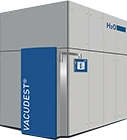Contact us
While relocating its production line, a manufacturer of high-end sealing systems for powertrains in China considered a new wastewater concept. For the company, which specializes in precision seals and modules made of elastomer, metal, and plastic materials for the automotive industry, environmentally compatible processes and the efficient use of water as a resource are important aspects.
As the regional water authority had already tightened the requirements for the discharge of wastewater, the traditional chemical/physical wastewater treatment plant already installed could no longer be operated.
Therefore, they opted for the most efficient and sustainable solution to treat its wastewater – zero liquid discharge by vacuum evaporation.
A water-based thin-film phosphating process is used in production to achieve a durable metal-rubber bond. This includes degreasing, activation, and phosphating of the steel components. The resulting wastewater mainly contains phosphates and heavy metals and was previously treated chemically and physically. Due to the so-called zero tolerance policy for phosphate and heavy metals, this wastewater may now no longer be discharged into the sewer system.
By recycling the distillate of the VACUDEST back to the production, the company can fulfill the requirements of the local government and in addition save water. The wastewater treatment system from H2O GmbH Germany was delivered, installed, and commissioned by H2O`s own subsidiary, H2O Kunshan. The water treated with VACUDEST vacuum distillation system is ideally suited for their own processes and can be reused as rinsing water without further treatment. The remaining evaporation residue is only a fraction of the original wastewater amount and can be disposed of at minimum cost.
Crystal clear distillate thanks to Clearcat technology
Vacuum distillation is a very efficient separation process for separating high-boiling impurities from industrial process water. Nevertheless, oils and fats from degreasing steps cannot be completely separated by distillation due to certain physical effects and traces are transferred to the distillate. This effect is known to all system manufacturers and can often lead to a cloudy distillate. Common follow-up treatments are based on coalescence separators and activated carbon stages. In addition to the running costs, there is also the increase in maintenance work.
Not so with the patented H2O Clearcat technology - this guarantees highest distillate quality without the use of the usual post treatment and consumables. This additional option for the innovative VACUDEST vacuum distillation system allows the safe and efficient treatment of industrial wastewater containing oil and grease in a single process step. The operating principle of the Clearcat condensation stage is based on physical and catalytic effects. Therefore, this cutting-edge technology requires neither energy nor auxiliary or operating materials. H2O improves the quality of treated water and sets new standards. The distillate thus becomes completely colorless and clear.
Evaporation Process
To keep the customer’s water budget cost-efficient and environmentally friendly, the distillate generated during vacuum distillation can be channeled back into the phosphating process. Of course, this can only be done if the water meets certain quality requirements. These requirements differ for each treatment or rinsing bath and are usually set by the suppliers of the degreasing, pickling and activation agents. The most important parameter is conductivity. At BRUSS, the distillate generated during the vacuum distillation process does meet the necessary conductivity requirements and needs no further treatment.
How does it work? All the rinse water and spend active baths are collected and neutralized before the wastewater is fed to the evaporator. Vacuum evaporation relies on the principle of difference in boiling points. When evaporating phosphating wastewater substances having higher boiling points than water (oil, fat, heavy metal salts) remain in the evaporation residue, like for instance lime and salts precipitate in a tea pot which has been forgotten on the oven. Industrial wastewater from phosphating is evaporated under vacuum of about 650 mbar at a temperature of about 86 °C. The emerging steam, free of heavy metals and salts, is compressed in a roots pump to atmospheric pressure. During compression the steam is heated to about 120 °C. This super-heated steam is then used to provide energy to the evaporation process. Compared to atmospheric evaporation the energy recovery is up to 95 %. Another advantage is that the distillate is free of bacteria.
All goals met
For the high-end seal manufacturer, a holistic optimization of their production processes is important. The H2O VACUDEST evaporation system helps to achieve and implement these and other sustainability activities like the environmentally sustainable and efficient use of the resource water. Zero Liquid Discharge.

The good treatment quality of the VACUDEST vacuum distillation plant enables to realize a Zero liquid Discharge production.
Effective treatment of used rinsing water can be useful, especially for companies with production sites in areas with problematic water supplies. Using a sustainable recycling system, production processes can be made wastewater-free - a significant contribution to the conservation for dwindling water resources. H2O GmbH is one of the world´s leading manufacturers of systems for wastewater recycling. Seven in ten of our customers are now completely wastewater-free.

You want to be part of our team and create the wastewater-free future with us?
We will tell you how!
Your contact is:
Bettina Böhringer
Human Resources
+49 7627 9239-201
career@h2o-de.com
You have questions on our VACUDEST systems?
Kindly contact us!
Your contact is:
Thomas Dotterweich
Senior Sales Engineer
+49 7627 9239-306
thomasm.dotterweich@h2o-de.com
You need consumables, spare parts or a maintenance date?
We will be pleased to assist you!
Your contact is:
Carles Fité
Technical Customer Support
+49 7627 9239-888
carles.fite@h2o-de.com